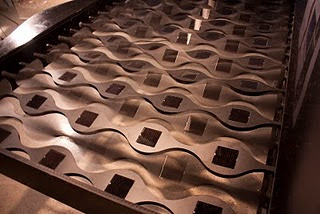The interdisciplinary aspect of this class was great. I think that these three fields and teach and learn a lot from each other, and that working together is critical in any one of their success. That was the major reason I signed up for the class, and even through frustration and seeming disaster, I still look view that as the most important part of the class.
It only makes sense that people learn to work with other people, for it working only with other art students for the rest of my life is not something i want, nor plan on happening. I think this is true for all disciplines. Whether or not any of us got better at working with other people can be up to speculation, however, I suppose it was quite the test, and we got a lot of practice!
It was great to get a better understanding of what other students are learning. Watching what other students excelled in or wanted to learn about was interesting.
I worked a lot with johanna and making decisions about the project as well as with the posters and pictures. When her and I sat down we made a ton of progress. It was much easier to work the two of us on the details than with the whole group, because decisions just needed to be made. We drew out pictures and talked about how everything would fit together and be structured. This was a huge step, for we were able to all be on board and have a greater understanding of the functioning of the project.
We then spent a lot of time taking pictures of the progress, editing, creating a template for the posters, and picking graphics and pictures that we wanted on the posters. We met a lot throughout the last three weeks to discuss various options and kept each other updated with newer versions. I was able to learn inDesign and incorporate work from everyone involved in the project. I spent a lot of time going back through our older brainstormings and inspirations. I wrote up all the text discussing goals and inspirations as well as the process we took to accomplish the project.
I also worked on the entire progress section of the paper. I went back and looked at our progress and how we got there. I discussed inspirations and goals (like in the poster), and our work process.
When it came down to construction, I was very excited, because that was something I really like to be a part of. I learned a lot about soldering and about solar panels. We did a ton of gluing, soldering, drilling, testing, and finger crossing that nothing would go incredibly wrong!
The begining of the class started off much more promising in terms of learning from the interdisciplinary aspect of the group. We were learning about alternative energy and each doing our own programming. People were brainstorming together, using different machines, constructing together, and really keeping each other updated. I would get emails daily from my group about what people were working on, and architects would be programming while engineers would be constructing, and art students would be creating files in digital project. THIS is what the class was meant to be.
For the final project I saw a lot less of this in my group (however I know it was still prevalent in others). Art and Architecture students were using digital project, constructing, etc, while engineers were programming. There were many weeks where group meetings existed only between the engineers or the architects. People were working on what they knew how to do instead of really stepping outside of the box. Overall, I feel this is true, although I do acknowledge that I have taken away a number of skills I DEFINITELY did not have before the class. I learned to solder and a lot about construction and such. I would love to have done a lot more programming and arduino work, for that was really interesting and fun.





















































